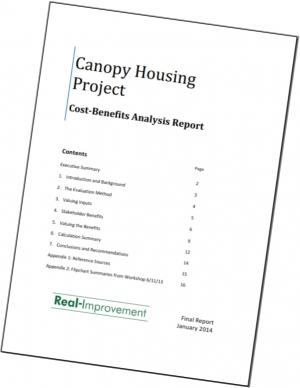



A report commissioned by Canopy Housing Project in Leeds and published early in 2014 shows the benefits that self-help housing can bring to a range of different stakeholders.
Written by Andy Bagley (Real-Improvements consultancy), this is a first-stage, preliminary report on the Social Return on Investment (SROI) provided by Canopy's project to bring empty homes back into use, a project which also draws in volunteers, provides homes, and helps people into training and work.
A fuller evaluation is understood to be in the pipeline: the current report notes
Stage Two of this project, developing a full SROI analysis, will take a much more rigorous approach, and will test with volunteers, tenants and other stakeholders exactly what benefits they experience in practice.
On the basis of the more limited methodology used in the report, Canopy has produced £4.28 of social value for each £1 of external investment. Examples of social value include obvious measures such as reduction in benefits payments but extend also to less obvious and perhaps less-easily-quantifiable measures such as "better family relationships".
Under-estimates?
It may be that the current report does not take into account all the benefits of the project. For example the following are not included:
- there is the widely-reported (but hard to access) research from Hometrack from June 2003 that found that neighbouring homes can lose up to 18% of their value if sited next to an empty property
- housing benefit savings to the local Council seem not to have taken into account the possiblity that tenants were previously in much more expensive homeless accommodation.
